National anthems of the Soviet Union and Union Republics
The Union of Soviet Socialist Republics and its constituent republics each had a national anthem (generally referred as state anthem).
The Russian Soviet Federative Socialist Republic, was the last republic in adopt a national anthem (1990), before this date had no anthem, and used exclusively that of the Union: The Internationale from 1917 to 1944 and the National Anthem of the Soviet Union from 1944 to 1990.
Unlike most national anthems, few of which were composed by renowned composers, the state anthems were composed by some of the best Soviet composers, including world-renowned Gustav Ernesaks (Estonia), Aram Khachaturian (Armenia), Otar Taktakishvili (Georgia) and Uzeyir Hajibeyov (Azerbaijan).
The lyrics present great similarities, all having mentions to Vladimir Lenin (and, in their initial versions, to Joseph Stalin), to the guiding role of the Communist Party of the Soviet Union, and to the brotherhood of the Soviet peoples, including a specific reference to the friendship of the Russian people (the Estonian, Georgian and Karelo-Finnish anthems were apparently an exception to this last rule).
Most of these anthems were replaced during or after the collapse of the USSR; Belarus, Kazakhstan (until 2006), Tajikistan, Turkmenistan (until 1997), and Uzbekistan kept the melodies, but with different lyrics. The Russian Federation itself had abandoned the Soviet hymn, replacing it with a tune by Glinka. However, with Vladimir Putin coming to power, the old Soviet tune was restored, with new lyrics written to them.
List of republics
 Soviet Union - National Anthem of the Soviet Union
Soviet Union - National Anthem of the Soviet Union Russian SFSR - The Patriotic Song
Russian SFSR - The Patriotic Song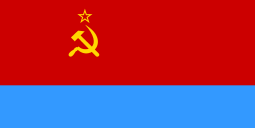 Ukraine - Anthem of the Ukrainian SSR
Ukraine - Anthem of the Ukrainian SSR Byelorussia - Anthem of the Byelorussian SSR
Byelorussia - Anthem of the Byelorussian SSR Uzbekistan - Anthem of the Uzbek SSR
Uzbekistan - Anthem of the Uzbek SSR Kazakhstan - Anthem of the Kazakh SSR
Kazakhstan - Anthem of the Kazakh SSR Georgia - Anthem of the Georgian SSR
Georgia - Anthem of the Georgian SSR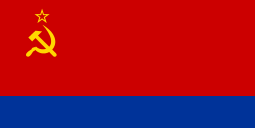 Azerbaijan - Anthem of the Azerbaijan SSR
Azerbaijan - Anthem of the Azerbaijan SSR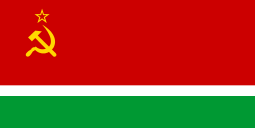 Lithuania - Anthem of the Lithuanian SSR
Lithuania - Anthem of the Lithuanian SSR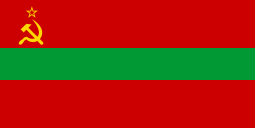 Moldavia - Anthem of the Moldavian SSR
Moldavia - Anthem of the Moldavian SSR Latvia - Anthem of the Latvian SSR
Latvia - Anthem of the Latvian SSR Kirghizia - Anthem of the Kirghiz SSR
Kirghizia - Anthem of the Kirghiz SSR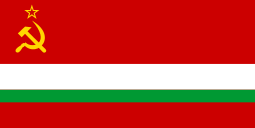 Tajikistan - Anthem of the Tajik SSR
Tajikistan - Anthem of the Tajik SSR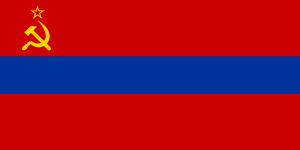 Armenia - Anthem of the Armenian SSR
Armenia - Anthem of the Armenian SSR Turkmenistan - Anthem of the Turkmen SSR
Turkmenistan - Anthem of the Turkmen SSR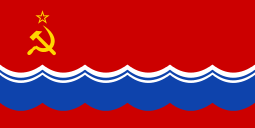 Estonia - Anthem of the Estonian SSR
Estonia - Anthem of the Estonian SSR
The Anthem of the Karelo-Finnish SSR was used for the Karelo-Finnish SSR before it was demoted to an ASSR within the Russian SFSR. With the exception of the Chechen-Ingush Autonomous Soviet Socialist Republic, Autonomous republics of the Soviet Union (ASSRs) did not have their own anthems.
Legal status
Like the hammer and sickle and red star, the public performance of the anthems of the Soviet republics and the anthem of the Soviet Union itself are considered as occupation symbols as well as symbols of totalitarianism and state terror by several countries formerly either members of or occupied by the Soviet Union. Accordingly, Latvia,[1] Lithuania,[2] Hungary[3] and Ukraine[4][5][6] have banned those anthems amongst other things deemed to be symbols of fascism, socialism, communism and the Soviet Union and its republics. However, in Poland, dissemination of items which are "mediums of fascist, communist or other totalitarian symbolism" was criminalized in 1997. However, in 2011 the Constitutional Tribunal found this sanction to be unconstitutional.[7] In contrast to this treatment of the symbolism, promotion of fascist, communist and other totalitarian ideology remains illegal. Those laws do not apply to the anthems of Russia, Belarus, Uzbekistan and Tajikistan which used the melody with different lyrics.
References
- ↑ "BC, Riga, 16.05.2013". The Baltic course. Retrieved 3 August 2014.
- ↑ "Lithuanian ban on Soviet symbols". BBC News. 17 June 2008. Retrieved 22 May 2010.
- ↑ Hungarian Criminal Code 269/B.§ (1993) "(1) A person who (a) disseminates, (b) uses in public or (c) exhibits a swastika, an SS-badge, an arrow-cross, a symbol of the sickle and hammer or a red star, or a symbol depicting any of them, commits a misdemeanour—unless a more serious crime is committed—and shall be sentenced to a criminal fine (pénzbüntetés)."
- ↑ Ukraine Bans Soviet-Era Symbols
- ↑ LAW OF UKRAINE. On the condemnation of the communist and national socialist (Nazi) regimes, and prohibition of propaganda of their symbols
- ↑ http://zakon4.rada.gov.ua/laws/show/317-viii
- ↑ "Nowelizacja kodeksu karnego." (in Polish). 2011-07-19. Retrieved 2015-04-08.
External links
- Audio recordings made by each republic's best national choir and orchestra in the 1970s-1980s; also instrumental versions by the Brass Band of the USSR Ministry of Defence from the 1968 Soviet LP.
